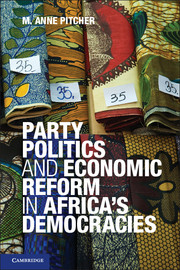Book contents
- Frontmatter
- Contents
- Tables, Figures, and Maps
- Acknowledgments
- Abbreviations
- Map
- 1 Understanding Institutional Development in Africa
- 2 From Motivational to Imperative Commitment
- 3 The Impact of Party Politics and Democratic Quality on Economic Reform
- 4 Party Fragmentation and Ad Hoc Private Sector Development in a Limited Democracy
- 5 Stable Parties, Limited Democracy, and Partisan Private Sector Development
- 6 Stable Parties, Liberal Democracy, and Strategic Compromise
- 7 Conclusion
- Appendix 1 Coding Scheme
- Appendix 2 Coding Scheme Indicators of Imperative Commitments
- Appendix 3 Effective Number of Parliamentary Parties (ENPP) in Nine African Democracies c. 1990s–2000s
- Bibliography
- Index
Appendix 2 - Coding Scheme Indicators of Imperative Commitments
Published online by Cambridge University Press: 05 June 2012
- Frontmatter
- Contents
- Tables, Figures, and Maps
- Acknowledgments
- Abbreviations
- Map
- 1 Understanding Institutional Development in Africa
- 2 From Motivational to Imperative Commitment
- 3 The Impact of Party Politics and Democratic Quality on Economic Reform
- 4 Party Fragmentation and Ad Hoc Private Sector Development in a Limited Democracy
- 5 Stable Parties, Limited Democracy, and Partisan Private Sector Development
- 6 Stable Parties, Liberal Democracy, and Strategic Compromise
- 7 Conclusion
- Appendix 1 Coding Scheme
- Appendix 2 Coding Scheme Indicators of Imperative Commitments
- Appendix 3 Effective Number of Parliamentary Parties (ENPP) in Nine African Democracies c. 1990s–2000s
- Bibliography
- Index
Summary
(6 point scale: 1 = lowest; 6 = highest; values of .5 are allowed)
1. Trade
Examines extent to which policy framework is conducive to cross-border trade by assessing tariffs and customs procedures
Average tariff is above 25 percent; many rates above 50 percent, no use of tariff bands; b. customs – endemic corruption, inconsistent and undocumented customs procedures.
Average tariff below 25 percent; many rates above 40 percent; more than five tariff bands; b. customs – widespread perception of corruption; slow collection of duties; some formal documentation of customs procedures but out of date and incomplete.
Average tariff below 20 percent; five or fewer bands; maximum band at 30 percent tariff; b. customs – frequent allegations of corruption; duty collection slow; procedures, regulations, and guidelines published, but need to be simplified.
Average tariff below 16 percent, four or fewer tariff bands, maximum band at 25 percent; b. customs – limited allegations of corruption; laws, regulations published and efforts to simplify; formal mechanisms for appealing customs.
Average tariff below 12 percent; three or fewer tariff bands, maximum band at 20 percent; customs – reputation for professionalism, few instances of corruption; speedy processing, laws are published, rationalized, simplified.
Average tariff rate less than 7 percent; maximum tariff rate 15 percent; customs – sound reputation for professionalism and integrity, speedy resolution of appeals; laws, regulations, and guidelines published, simplified, rationalized.
- Type
- Chapter
- Information
- Party Politics and Economic Reform in Africa's Democracies , pp. 253 - 258Publisher: Cambridge University PressPrint publication year: 2012

